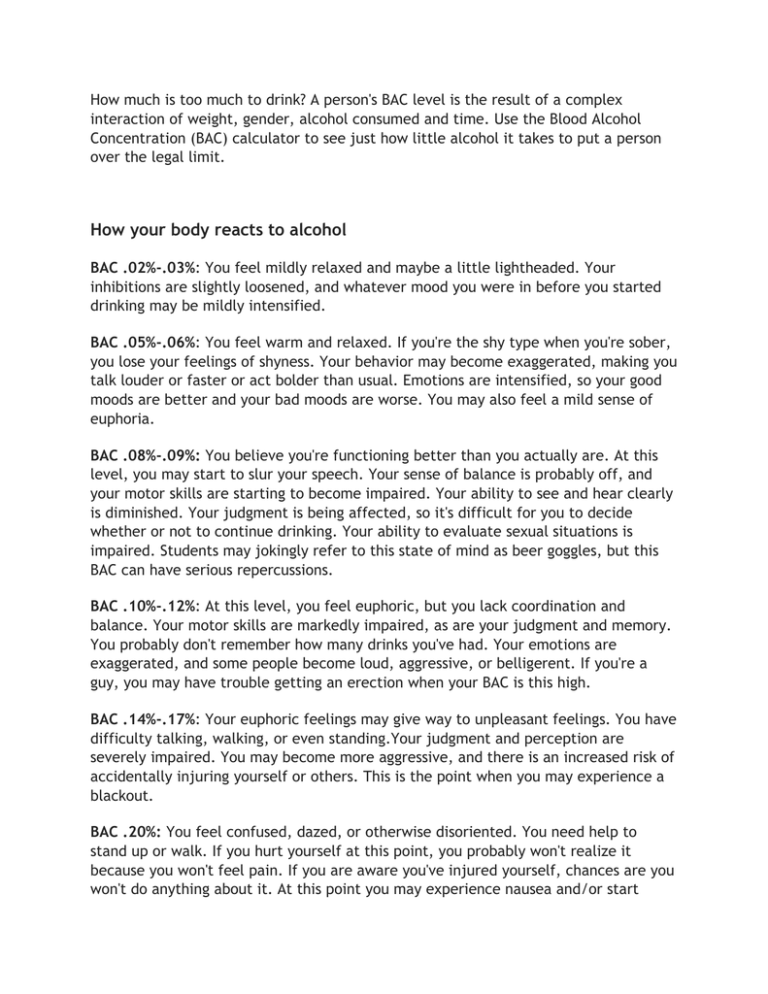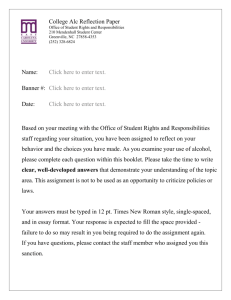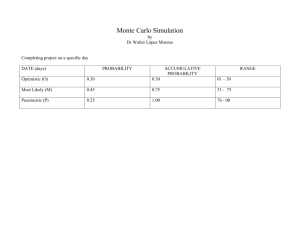
How much is too much to drink? A person's BAC level is the result of a complex
interaction of weight, gender, alcohol consumed and time. Use the Blood Alcohol
Concentration (BAC) calculator to see just how little alcohol it takes to put a person
over the legal limit.
How your body reacts to alcohol
BAC .02%-.03%: You feel mildly relaxed and maybe a little lightheaded. Your
inhibitions are slightly loosened, and whatever mood you were in before you started
drinking may be mildly intensified.
BAC .05%-.06%: You feel warm and relaxed. If you're the shy type when you're sober,
you lose your feelings of shyness. Your behavior may become exaggerated, making you
talk louder or faster or act bolder than usual. Emotions are intensified, so your good
moods are better and your bad moods are worse. You may also feel a mild sense of
euphoria.
BAC .08%-.09%: You believe you're functioning better than you actually are. At this
level, you may start to slur your speech. Your sense of balance is probably off, and
your motor skills are starting to become impaired. Your ability to see and hear clearly
is diminished. Your judgment is being affected, so it's difficult for you to decide
whether or not to continue drinking. Your ability to evaluate sexual situations is
impaired. Students may jokingly refer to this state of mind as beer goggles, but this
BAC can have serious repercussions.
BAC .10%-.12%: At this level, you feel euphoric, but you lack coordination and
balance. Your motor skills are markedly impaired, as are your judgment and memory.
You probably don't remember how many drinks you've had. Your emotions are
exaggerated, and some people become loud, aggressive, or belligerent. If you're a
guy, you may have trouble getting an erection when your BAC is this high.
BAC .14%-.17%: Your euphoric feelings may give way to unpleasant feelings. You have
difficulty talking, walking, or even standing.Your judgment and perception are
severely impaired. You may become more aggressive, and there is an increased risk of
accidentally injuring yourself or others. This is the point when you may experience a
blackout.
BAC .20%: You feel confused, dazed, or otherwise disoriented. You need help to
stand up or walk. If you hurt yourself at this point, you probably won't realize it
because you won't feel pain. If you are aware you've injured yourself, chances are you
won't do anything about it. At this point you may experience nausea and/or start
vomiting (keep in mind that for some people, a lower blood alcohol level than .20%
may cause vomiting). Your gag reflex is impaired, so you could choke if you do throw
up. Since blackouts are likely at this level, you may not remember any of this.
BAC .25%: All mental, physical, and sensory functions are severely impaired. You're
emotionally numb. There's an increased risk of asphyxiation from choking on vomit
and of seriously injuring yourself by falling or other accidents.
BAC .30%: You're in a stupor. You have little comprehension of where you are. You
may suddenly pass out at this point and be difficult to awaken. (But don't kid yourself:
Passing out can also occur at lower BALs. But, at lower blood alcohol levels, you may
decide you've had enough to drink and go "pass out." With an alarming BAL like .30%,
your body will be deciding to pass out for you.)
BAC .35%: This blood alcohol level also happens to be the level of surgical anesthesia.
You may stop breathing at this point.
BAC .40%: You are probably in a coma. The nerve centers controlling your heartbeat
and respiration are slowing down, s-l-o-w-i-n-g d-o-w-n, s-l-o-w-i-n-g d-o-w-n. it's a
miracle if you're not dead.
Courtesy of University of Denver





